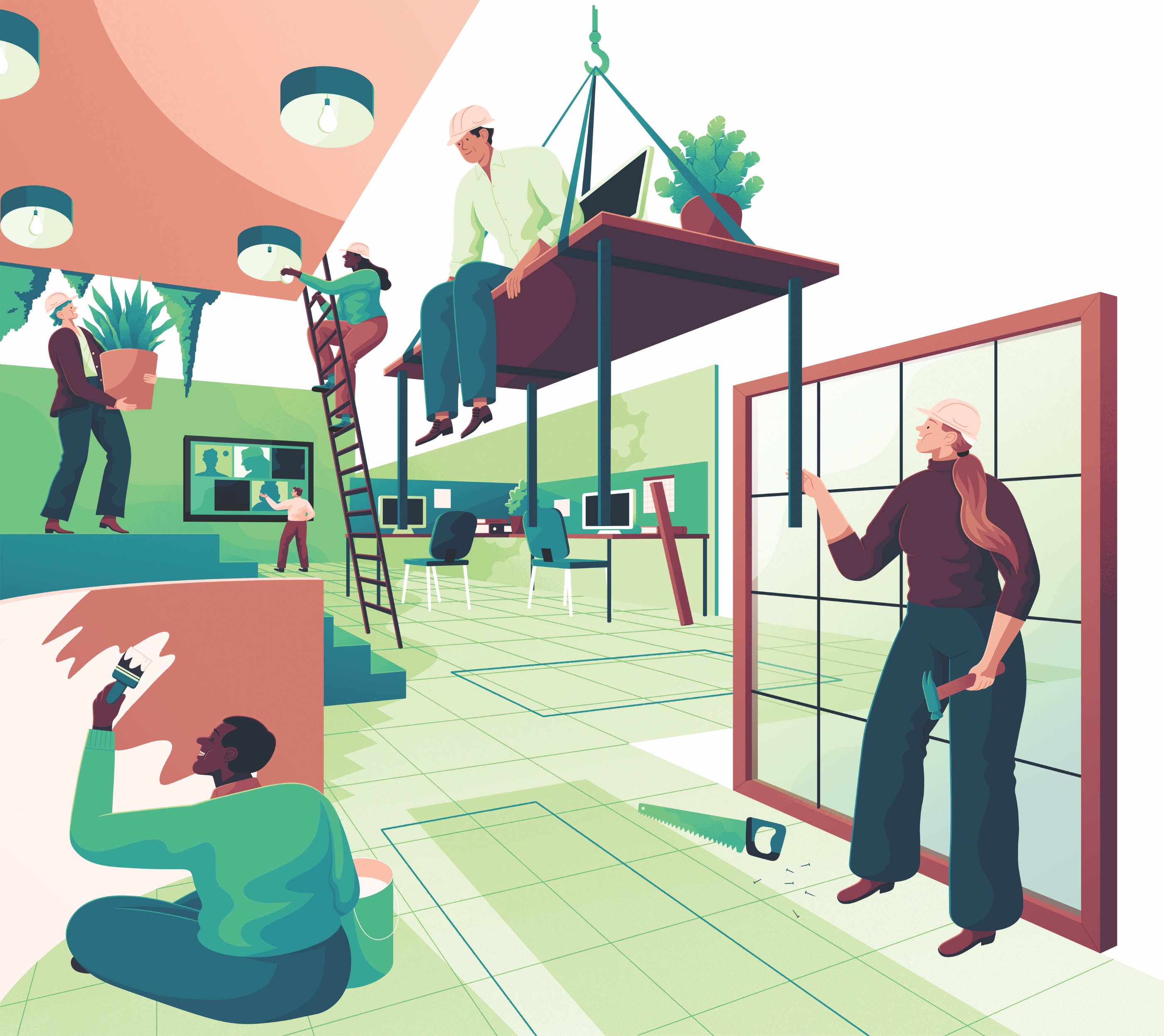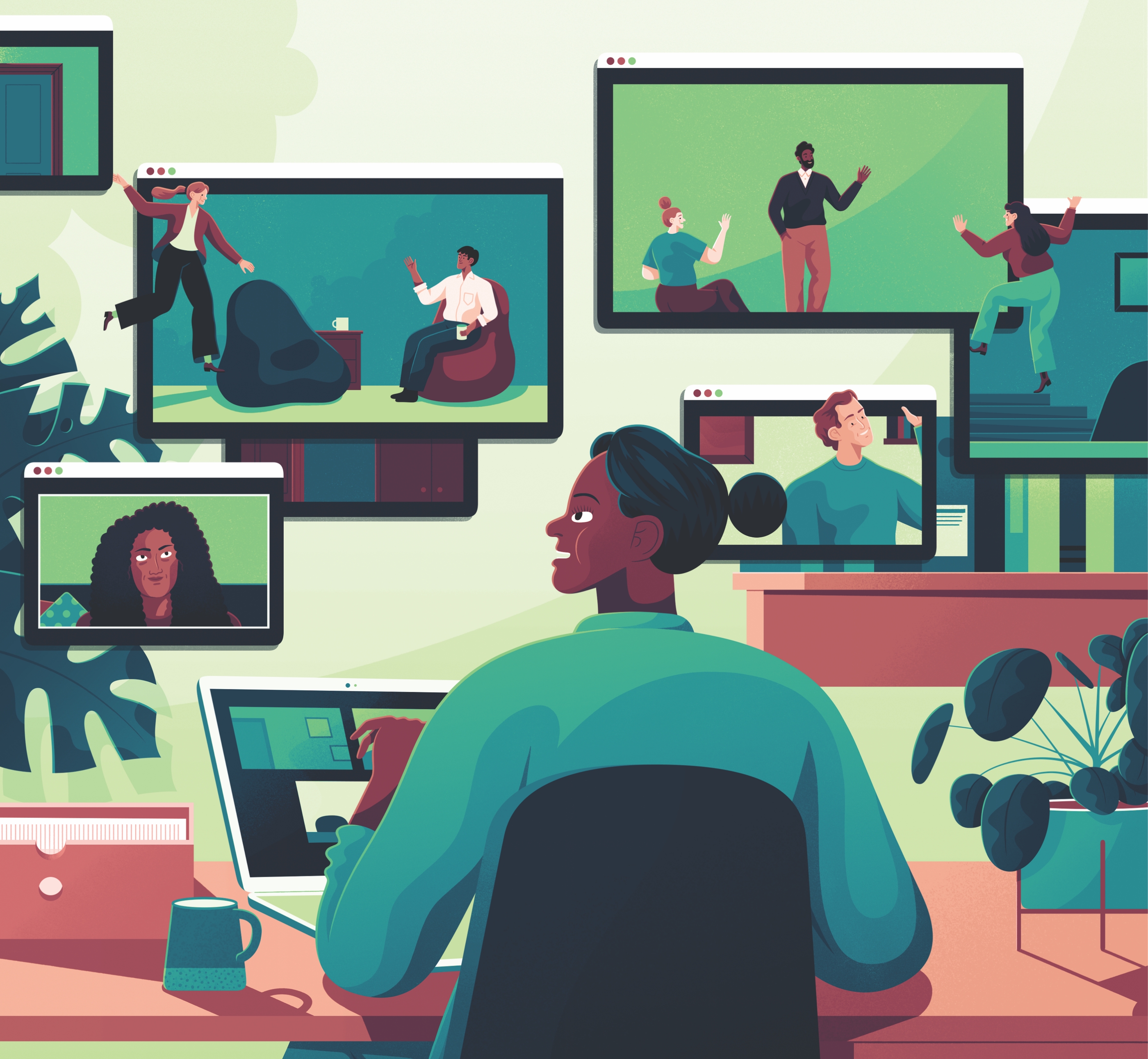The way the world does business transformed abruptly two years ago when COVID-19 forced large numbers of offices to switch to remote work. That experience — combined with the sobering reality of illness and death resulting from the pandemic — caused many workers to reevaluate their relationship with their job. In a phenomenon known as “The Great Resignation,” millions of employees quit their positions, sometimes without another one lined up.
Inflection Point
EIGHT WAYS THE WORKPLACE IS CHANGING DURING ‘THE GREAT RESIGNATION’
May 23, 2022
By
Tina Eshleman
A fall 2021 report by management consulting firm McKinsey & Co. revealed that 40% of workers in the United States, Canada, the United Kingdom, Australia and Singapore indicated they were at least somewhat likely to quit in the next three to six months. Of those surveyed, 18% said they were likely to almost certain they would leave their jobs. In 2021, over 47 million people resigned, according to the U.S. Bureau of Labor Statistics. Last November alone, a record 4.5 million workers quit.
The reasons vary. Women, who still shoulder more responsibility for child care, are reevaluating whether it makes sense to keep working and paying for after-school care and taking vacation days to be at home when children are out of school. Some left the workforce during the pandemic because of school closings or to care for family members. Many workers are considering whether they want to continue commuting two hours a day. Others are less willing to remain in a work environment that lacks diversity and inclusivity. In McKinsey’s survey, employees who identified themselves as non-white or multiracial were more likely than their white counterparts to say they had left their jobs because they lacked a feeling of belonging.
In addition, baby boomers are retiring at a higher rate than before the pandemic, according to an analysis published by the Federal Reserve Bank of St. Louis. Senior economist Miguel Faria-e-Castro writes that COVID-19 was a motivating factor for older people, who are more vulnerable to infection and serious illness. In addition, retirement became more feasible for some older workers as assets such as housing and stocks rose in value.
To make sense of what’s happening, we turned to William & Mary leaders and alumni working in human resources in a variety of industries, including online retail, telecommunications, real estate, technology, education services and entertainment. During interviews and panel discussions, they shared insights about what’s driving change and what employers are doing about it.
“We’ll never see what we had before,” says Raelene Canuel Wagoner ’87, P ’20, vice president of talent management at Unison, a software and data provider for government contractors and federal agencies, and secretary of the William & Mary Foundation. “People value the flexibility too much. It varies by industry, but we will never, as a whole, go back to five days a week in the office.”
Along with significant challenges of navigating the changing tides, these HR professionals see an opportunity to build a better working environment.
“What I love most about this period is how it is fostering experimentation on the part of organizations and individuals. It’s emboldening us,” says Christa Schuchart Hokenson ’93, chief human resources officer at Strategic Education Inc., which comprises Strayer University and the Jack Welch Management Institute, among other programs. Her advice: “Be open to the possibilities and put them on the table yourself.”

A Power Shift Is Taking Place. Employees have more input in their work environments, especially those who work in high-demand jobs such as digital analytics, finance, marketing and product management, as well as skilled trades. “People who have the capabilities and transferrable skill sets to go across different industries — they’re
moving,” says Holly Tyson ’93, chief people officer at Cushman & Wakefield, a global real estate services company. “They’re saying, ‘What do I want to do with my life? Where can I make the biggest impact? What’s the purpose of the role I play in the world?’ We’re all experiencing some existential reassessment right now.” Tyson, along with Hokenson, William & Mary Chief Human Resources Officer Chris Lee and Clem Cheng ’86, senior vice president of human resources at Comcast, participated in a March panel discussion on “The Great Resignation: Competing for Talent in a Changing World,” as part of William & Mary Professionals Week, organized by the W&M Alumni Association and moderated by Latoya Asia J.D. ’09, director of talent acquisition and workforce planning at Dominion Energy. “It’s a good time to be a worker,” Cheng says. “People have lots of options and choices.”
Hybrid Work Is Accelerating and Employees Are Seeking Flexibility. These kinds of arrangements were already going on before the pandemic, but it was more on a case-by-case basis. According to a report by Cushman & Wakefield, on average, most employees in the U.S. were in their office 60% of the time before the pandemic. Pre-COVID, about 25% of workers spent part of their work week at home, Tyson says, and she expects that to be 50% going forward. “Interestingly enough, it’s really just a codification of what was happening before,” she says, adding that even so, many employers have struggled to define what their new policies will be. “Now, companies have to shine a light on flexibility or they’re going to lose their worker talent,” Tyson says. However, this presents a challenge for employers seeking a consistent approach: What happens when Manager X wants people in the office two days a week and Manager Y wants them there four days a week? “That’s the fog and confusion we’re managing,” Lee of W&M said during the March panel discussion. At online retail giant Amazon, where the workforce of 1.3 million in the U.S. ranges from frontline logistics workers whose jobs cannot be done remotely to people who do software development and artificial intelligence, the work arrangement varies by group, says Ardine Williams, vice president for workforce development at Amazon and a member of William & Mary’s Board of Visitors. “We’ve accelerated the transition of some cultures that were office only to, in a very short order, having to embrace hybrid or remote only,” she says. “After two years, people have said, ‘I never thought this would work, but guess what? It worked.’ The policy now is that the director-level folks are going to decide what makes the most sense for the work they do for the customers, whether they pick a certain day that they’re in the office or certain contact hours.”
Employers Are Finding New Ways to Build Organizational Culture and Foster a Sense of Belonging. With the changing norms come challenges, Williams says: “When you hire hundreds of thousands of people who have never been to an office, how do you grow culture? How do you build personal connections? How do we
help people learn the less formal pieces of how work gets done in a way that’s not only efficient and practical, but also helps build relationships? That’s the other side of the coin and that’s what we’re wrestling with now. Those relationships and that foundation of trust are incredibly important because that’s what makes the work easier.” Before the pandemic, people who participated in meetings remotely often felt left out, Wagoner says. If they called in, they couldn’t see anyone, and if they were on video, their view might be a room full of tiny heads. New technology can help, such as a camera called Meeting Owl that turns toward the person speaking and shows their face. Comcast is redesigning its conference rooms to incorporate such innovations, Cheng says. “The watercooler has to be architected when people are remote,” Tyson says, referring to the need for interactions with people who aren’t involved in your typical workflow. Wagoner emphasizes the need for frequent conversations, even when remote: “Every [Microsoft] Teams meeting is face-to-face,” she says. “I think that’s really important. I use the chat like I would stop by your office — ‘Are you there? Do you have five minutes?’ You need to reach out to people a lot.”
Companies are also improving virtual experiences by using breakout groups to encourage people to talk about a topic. Polling, trivia games and interactive online training courses are other tools. Unison has redesigned what used to be a multiday, in-person training program to be more accessible and effective virtually.
The Office Experience Is Evolving. “We’ll continue to meet in person for gatherings where it makes sense,” Wagoner says. “For onboarding, ideally you have more time in person, up front. There’s a need for social events, post-pandemic. There are activities such as whiteboard meetings that are very valuable to be in person. But what we heard from our employees was that doesn’t need to be in a rhythm of one or two days a week.” Because Cushman & Wakefield manages office space and leasing, Tyson is in a position to help shape the way physical workplaces are being reconsidered. “How do you structure those office experiences to be purpose driven?” she says. “Getting people together to accomplish something, to collaborate, to connect, to inspire and innovate — that’s going to be the future of work when we are not calling in remotely.” She expects a move toward hybrid space: “Because people aren’t going to be at their desk in the office five days a week, there’s going to be more sharing of space so that collaboration and human connection are reinforced and supported with the physical space around them.” Human connection is vital to ensuring long-term productivity, Tyson emphasizes. “Some people have become disconnected and it will be incumbent on successful companies to rebuild that connection,” she says.
“If you take the time up front to build relationships and understand what’s important to people, then you can move more quickly to accomplish your goals.”

The New Work Environment Requires Different Leadership Skills. Managers need to be empathetic and they need to be able to listen. Being remote created a more intimate relationship in some ways, because people were seeing inside each other’s homes via virtual video calls — learning the names of colleagues’ pets, seeing children play in the background. Tyson says that during a weekly Microsoft Teams call with her leadership team, she knows that at 8 a.m., one member of the group is going to be braiding her daughter’s hair on camera before sending her off to school. “I make a point of saying hi to her daughter,” Tyson says. “I think leaders need to acknowledge and celebrate the holistic, authentic selves that we all are.” While the pandemic brought substantial changes to the world of work, the movement for social and racial justice after the killings of George Floyd and other Black Americans has been equally important, Cheng says. “People being able to convey how they feel and think about things is so important around having a healthy organization,” he says. “If you’re a leader today and you don’t have that ability to empathize and really listen and understand, you’re done. That is not going to work going forward.” Starting in 2020, Comcast held a series of listening sessions that initially revolved around issues raised by Floyd’s death. “We’ve expanded that in terms of trying to listen hard around all aspects of what people need,” Cheng says. “People don’t want a lot of bureaucracy.” Rather, he says, they want to know their work is contributing to what the company is trying to achieve and how their company’s objectives help the community or society at large.
Competition for Employees Means Rethinking the Hiring Process. Companies are finding they need to speed things up. “The longer it takes, the more opportunity there is for someone to get that candidate,” says Ardine Williams of Amazon. Also, “are you communicating with that person and building that relationship?” She says Amazon is working toward “taking friction out of the equation” by providing a one-stop application process that matches prospective employees with open positions. Remote and hybrid jobs present an opportunity to widen applicant pools because employers can draw from a wider geographic area, says Logan Scott ’13, manager of diversity and inclusion at The Walt Disney Co., who participated in the 2021 W&M Professionals Week discussion on “Diversity, Equity and Inclusion in the Workplace: Strategies and Stories.” Companies are also starting to explore untapped segments to bring in more talent, such as looking at people who have taken breaks from the workplace or those whose resumes don’t match traditional expectations, Scott says: “Instead of the academic degrees or the previous experience, you think about skills that give them a lot of potential to build on.” Looking beyond previous notions of “fit” when filling positions can help organizations develop more diverse teams, says Williams: “At Amazon, the question we ask at the end of the interview is, ‘Does this person raise the bar?’ If you’re just looking for fit and not for what someone can bring, you get mediocrity.” Companies that make diversity a priority have a competitive advantage, Scott says. “That is where creativity and innovation are born — out of diverse perspectives,” he says. “DEI is the driver for success for any organization when it’s done right.” He predicts that artificial intelligence will become more widely used in how employees are hired and evaluated. “AI will influence the way folks recruit,” he says “I also think it may play a role in how people evaluate performance. If AI can be done in an inclusive way, it can help folks mitigate bias.”
There’s a Bigger Emphasis on Retention. Part of that is responding to what employees need and want, and making sure they feel valued and appreciated. Unison surveyed employees about returning to the office and made adjustments. “In our industry, if we had forced our software engineers to come back to the office even one day a week, we would have lost them,” Wagoner says. The company also conducts “stay interviews” each year. Every employee is asked the same set of questions, such as: “Why do you stay, what would entice you to leave, what skills do you have that you’re not using?” Pay and benefits should be competitive, but those are not always the deciding factors in whether an employee stays or goes, Wagoner says. “When you have a resignation problem, you have to understand why. Companies obviously do exit interviews, but that’s too late,” she says. “First and foremost, culture is so important, and a positive work environment. Through the pandemic, people have decided life is too short to work for jerks.”
Opportunities for Workplace Career Development Are Expanding. Williams says employees want to know there’s an opportunity to expand their skills and increase their job options and career resiliency if their job is phased out. During the pandemic, Amazon’s technical academy — which provides education for those who want to work as a software engineer — pivoted and went to a virtual model, which made it possible for a broader range of employees to take advantage of it. “The ability to add skills to experience so that you can grow your career is incredibly important,” Williams says. Employees measure the value of what they gain from work against the time and effort they put in, she adds. “I trade a day of my life for every day I come to work. Does the math work? If it doesn’t, they’re reconsidering. Part of what makes the math work is for people to not only be appreciated at work and have flexibility they need for their families, but also to have the opportunity to grow and build on the skills they have so they can take that next step.”
